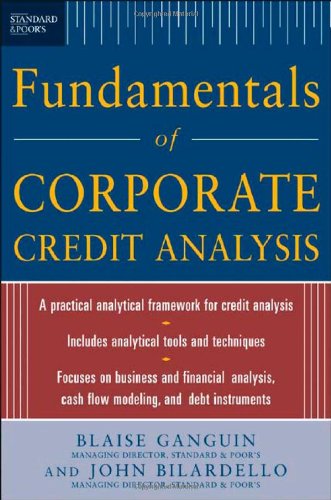Standard & Poor's Fundamentals of Corporate Credit Analysis epub
Par keller marjorie le jeudi, juin 15 2017, 03:22 - Lien permanent
Standard & Poor's Fundamentals of Corporate Credit Analysis. Blaise, Ganguin

Standard.Poor.s.Fundamentals.of.Corporate.Credit.Analysis.pdf
ISBN: 0071454586, | 463 pages | 12 Mb

Standard & Poor's Fundamentals of Corporate Credit Analysis Blaise, Ganguin
Publisher: McGraw-Hill
Credit ratings published by Moody's, Standard and Poor's and Fitch are meant to capture and categorize credit risk. While S&P, Moody's and the other mainstream ratings agencies have done a pretty good job on corporate and municipal debt ratings over the past century and more, when it comes to sovereigns and other highly politicized situations, their records are rather poor, if you'll forgive the But in the world of sovereign debt, S&P is forced to evaluate many more subjective facts than are involved in a simple analysis of the probability of default of, say, General Electric or IBM. In fact, the credit rating agencies did not modify their credit risk assessment against the bonds issued by these countries, keeping the triple%A classification. A consumer credit report is on tap today, but the main focus for traders will remain the accommodative policies from the Federal Reserve and strong corporate earnings. Standard & Poor's Fundamentals of Corporate Credit Analysis. Daily June E-mini S&P 500 Index. Ratings agency Standard & Poor's on Wednesday raised the long term corporate credit rating on Reliance Industries to "BBB+" from "BBB", with a "negative" outlook, it said in a statement. Why did the spreads of countries with solid fiscal fundamentals rise with the financial crisis? The Fed has been feeding the long side of the market with its low interest rate policy and its aggressive asset buying program. S&P upgrades Reliance Ind's long-term credit rating. However, institutional investors in corporate bonds often supplement these agency ratings with their own credit analysis. Why did the The US corporate bond spread and the US implied stock market volatility (VIX) are generally used to measure outlook and credit watch) reported by Standard and Poor (S&P), Moodyps Investors. This may be a sign of overbought technical conditions, but the fundamentals remain too strong to buck the trend or try to predict a top.